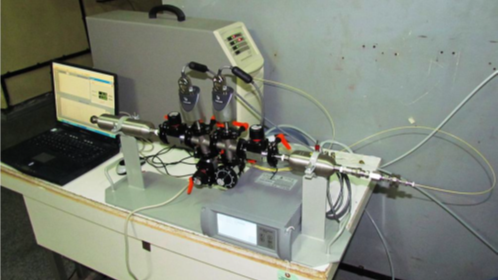Improving Fission Gases Composition Measurements
Structural changes during irradiation of the ceramic UO2 nuclear fuel, namely grain growth, swelling and creep may occur. Irradiation-induced swelling is a significant cause of the fuel cladding failure, and the common cause for irradiation swelling of ceramic fuels is the formation of fission gas bubbles. The diffusion coefficient is dependent on the bubble radius.
In order to study the behaviour of fission gases in the nuclear fuel, an installation for cladding puncture and fission gas analysis, was designed and manufactured at RATEN ICN.
The installation is able to puncture the fuel cladding, to take gas samples, to measure the pressure and the volume of gases, to measure the unknown volumes and to determine the chemical/isotopic composition of the fission gases by a quadrupole mass spectrometer.
Another application of this installation is to determine the quantity of fission gases released during disassembly of U targets irradiated for the production of Mo99 used for medical purposes. The target consists of low enriched uranium metallic foil wrapped with Ni foil and tight fixed between two Al cylinders.
After irradiation, the target is disassembled and uranium foil is recovered for dissolution. During the target disassembling fission gases released from uranium irradiated foil escape in the hot cell and they cannot be retained by the filters from the ventilation system. In this case, it is of great interest to know the quantity of fission gases released into the atmosphere. During the treatment and elimination of gaseous, waste is solved by an efficient off-gas system. Xenon and Iodine isotopes are trapped on special materials for decay before elimination in atmosphere.
The installation for cladding puncture and analysis of fission gases consist of:
- cladding puncture tool (installed in the hot cell);
- vacuum system with precise linear vacuum gauges and control panel;
- gas analyzer type SRS QMS 200.
The cladding puncture tool is used to fix the fuel rod, to vacuum-seal by a rubber gasket with a central hole, puncture the cladding and capture the fission gases in a vessel for further analyses. The cladding is punctured through the central hole of the gasket with a sharp tool.
Vacuum system consists of a mechanical vacuum pump, two precise linear vacuum gauges (ranges: 10-3÷2000 mbar and 1÷2000 mbar), electromagnetic and manual valves and a control panel. The pressure can be measured with a precision of ± 1 mbar in the range 1÷2000 mbar and the vacuum pump can get down to 5x10-3 mbar.
Gas analysis is done with an SRS QMS 200 quadrupole mass spectrometer that operates under high vacuum. A small fraction of the gas molecules are ionized to create positive ions and the resulting ions are separated, detected and measured according to their molecular masses.
The SRS QMS 200 gas analyzer is designed and widely used to quickly identify the molecules present in a gas, and when properly calibrated, can be used to determine the concentration or partial pressure of the components of a gas mixture.
The QMS 200 instrument can be considered as having two main subsystems: the gas handling and the analyzer. The gas handling system consists of a turbo pump, a diaphragm pump and valves that deliver the sample gas to the analyzer.
The mass spectrometer can perform both analog and histogram scans over its entire mass range, analog scanning being the most basic operation. During the analog scanning, the quadrupole mass spectrometer is stopped at fixed mass increments through a pre-specified mass range. The ions current is measured after each mass-increment step and transferred to the host computer. Analog scanning allows the detection of fractional masses and provides the only direct view of the peak shapes and resolution of the instrument.

A device for efficient calibration of the SRS QMS 200 gas analyzer was designed, manufactured and tested at RATEN ICN.
This device is able to reproduce volume end pressure condition for pure gases used in regular measurements and also mix pure gases in known proportions.
After the first test, it was found that the mass spectrometer response is not linear for a wide scale of partial pressures (more than three orders of magnitude) as it is in the case of fission gases measurement. Additional tests are required in order to get more accurate results.
The calibration of the mass spectrometer has to be made with gases mixtures in conditions as close as possible to those used for fission gas measurement. The mass spectrometer is sensitive to inlet pressure.
For the case of CANDU fuel rods irradiated under normal conditions (i.e. without any irradiation incident), a very small quantity of fission gases are released from fuel pellets in the void volume of the element.
It is necessary to measure unknown volumes with a high precision because the internal void volume of a CANDU fuel rod is less than 2 cm3 and a standard deviation of 0.1 cm3 lead to a relative error greater than 5%.
The measured isotopic compositions of Kr and Xe are in good agreement with those obtained using ORIGEN code.
Dr. Marin Mincu
RATEN ICN
marin.mincu@nuclear.ro